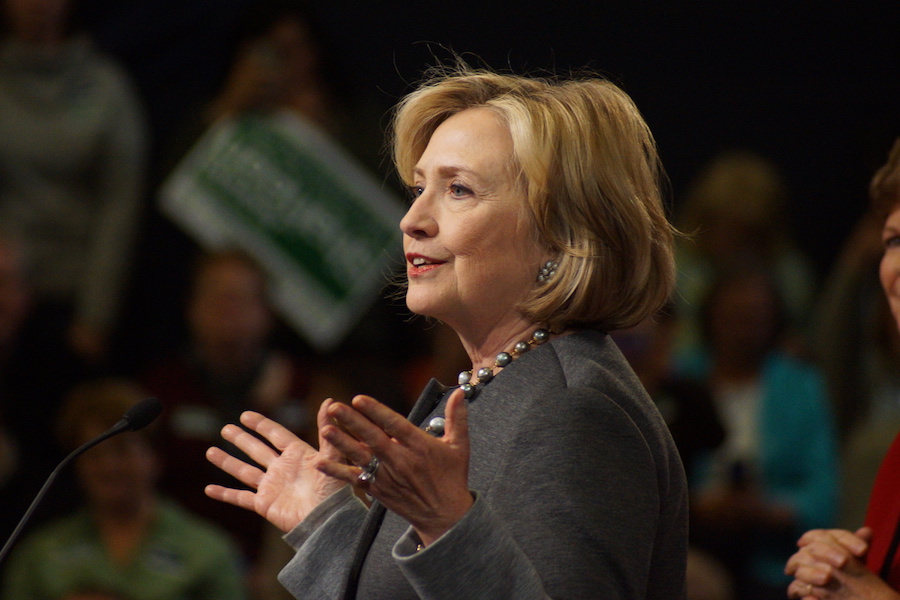Hillary Clinton’s campaign promise to put her husband in charge of “revitalizing the economy” has raised questions about Bill Clinton’s economic legacy, and how his approach would serve Americans in the 21st century.
Rana Foroohar, in her new book, Makers and Takers: The Rise of Finance and the Fall of American Business, warns that despite the rosy picture painted by the Clintons of the U.S. economy during the 1990s, that was the decade “when wages for all Americans started to stagnate.” She concludes that Clinton Administration policies such as the deregulation of derivatives, changes in tax deferment of options and in corporate compensation helped create a dangerously unbalanced economy dominated by Wall Street.
“While not everything was bad,” says Foroohar, “I want to hear her spelling out in much greater detail what it means to put Bill Clinton in charge of the economy. If it means deregulation, executives being able to tax-defer more options pay, and a laissez-faire attitudes toward markets, that’s not what we need right now.”
In the event that she won the presidency, Foroohar warns that Clinton would need a “much, much broader and more diverse group of advisors, particularly in the economic sphere.” As she sees it, “there is way too much of the ’90s crowd still present, and we need more diversity… The best question is the simplest one — is the financial system serving business and the real economy? All too often, the answer is no.”
In her book, Foroohar, TIME magazine assistant managing editor and economic columnist and global economic correspondent at CNN, explains the dangers of financialization — the growth of the financial sector relative to the rest of the economy. She reveals that the financial system no longer funds new ideas and projects as much as it feeds off Main Street. The book includes conversations with Institute of New Economic Thinking (INET) chair Adair Turner, president Rob Johnson, and grantees Joseph Stiglitz and William Lazonick. (See Lazonick, ” The Financialization of the US Corporation: What Has Been Lost, and How It Can Be Regained” and Turner, “The Failure of Free-Market Finance”).
‘If we wonder why we have a 2 percent economy eight years and $4 trillion worth of monetary stimulus on, we should look at the fact that the capital markets are simply not doing what they were set up to do’
Adam Smith-style market capitalism, says Foroohar, was supposed to funnel our savings into productive investments in new businesses, which would in turn create new jobs and growth in a virtuous cycle. But today, “only about 15 percent of money coming out of the financial institutions makes it way into business investment.” That, she says, is a broken system. The rest of the money is going into a “closed loop of finance… buying and selling existing assets like stocks, bonds, houses instead of going into new business investment.” Because this process tends to bid up existing assets, it results in bubbles and reinforces inequality, while underlying growth is degraded. “If we wonder why we have a 2 percent economy eight years and $4 trillion worth of monetary stimulus on, we should look at the fact that the capital markets are simply not doing what they were set up to do,” she says.
Foroohar sees the rise of Donald Trump and Bernie Sanders as pointing to “the sense that people of all political stripes have lost faith in the establishment answers and establishment candidates.” In her view, Hillary Clinton’s failure to generate enthusiasm even when faced with a candidate as flawed as Trump speaks to voters who want “something really different” and “don’t want to go back to the ’90s.”
Trump, in fact, has repeatedly suggested that financialization has not served the U.S. well, despite the fact that as a real estate operator he enjoyed exceptionally favorable deals from bankers and financiers. Foroohar’s reporting has revealed that the GOP candidate was able to negotiate plum deals during his four bankruptcies simply because “he had put his name on so many things — it would be too expensive for the [casino] operators to go in and wipe the big T off the carpets and the toilets and the cup holders.” She finds it ironic to hear a message of economic populism delivered by someone who, as a purveyor of highly-leveraged commercial real estate deals, “has benefitted more from the Wall Street model than certainly any other politician in recent memory except for maybe Mitt Romney.” And that prompts her to ask whether Trump has any policy alternatives that would improve the economic prospects of rust-belt workers.
On financial reform, Foroohar sees little promise in Hillary Clinton’s insistence on working within the existing (and weakened) Dodd-Frank regulation. The challenge of reform, the author argues, extends beyond Too Big to Fail banks to “tax policy, housing policy, how retirement is structured, and how the asset management business works.” She finds the current level of policy debate among candidates disappointingly limited at a time when a our economic system is “deeply dysfunctional whole” because of the “huge disconnect between the capital markets and the real economy over 40 years.”
Foroohar notes that Wall Street and the business community in general are not certain which candidate will support their interests. The Street, she says, is concerned about what a Trump presidency could mean underlying growth: “It’s such an unknown variable. Is this guy truly nuts? Or is he some kind of pragmatist who will put aside a lot of the really awful rhetoric and maybe make more reasonable decisions in office?”
She sees that anxiety as driving them towards the Clinton camp: “Sure, she’s talked about banking regulation on the campaign trail as she was being pushed to the left by Bernie Sanders and took a stronger position on that, but I don’t see her signaling any kind of profound shift in the system.” Bankers may be comforted by a candidate who doesn’t threaten to break them up or substantively change the fundamental structure of the capital markets.
On the international front, Foroohar finds trade deals like the Trans-Pacific Partnership (TPP) Agreement, rejected by Trump and Sanders but supported by Clinton, as part of the intersection of financialization and globalization, and a sign of “a fundamental economic system that isn’t serving labor very well and thus isn’t serving the overall economy very well.”
Foroohar is from Indiana, and understands why many voters in that state would support Donald Trump: “White working class men haven’t gotten a raise in real terms since 1968. That’s in part because of the way we’ve cut free trade deals.” She is hopeful that at least there is now discussion about who is losing out from free trade deals, but would like to see more, “particularly when we’re out in the global marketplace with countries like China, Russia, and Brazil who just don’t play by the same rules. “
Financialization has also shaped government responses to economic challenges during the Obama era. Due to a lack of real fiscal policy and gridlock in Washington post-2008 financial crisis, the Fed pumped large amounts of money into the economy, much of which “went into short-term hot money played in commodities and in countries that are essentially plays on the commodities market — China, Russia, Brazil.” She warns that the tide is now flowing back out and creating tremendous volatility. “The fact that a bank like Goldman Sachs can be so huge now in the commodities markets is itself a problem… The fact that bankers can now compete with their customers to create more fragility in the markets rather than real underlying growth in investment really ought to be a crime.”
Foroohar is hopeful regarding opportunities for the left and the right to find common ground on financialization in areas like small business investment, which has dropped precipitously since the 1970s, in part, as she explains, because lending is no longer the primary business model of banks. She also sees potential for collaboration on tax policy, which both sides agree is failing to incentivize the right things. But when it comes to the balance between Wall Street and Main Street, left/right categories are too simple — the divide between who wants transformation and who doesn’t is also significant. “A large swath of working and middle class America —whatever their political stripes — feels that the current system is not serving them well.”







